Ethical Principles for Physical Restraint in Nursing Practice
VerifiedAdded on 2023/06/13
|6
|1539
|460
AI Summary
This assignment discusses the ethical principles for physical restraining of patients in nursing practice. Alternative ways to eliminate physical restraint from the process of patient control are also discussed.
Contribute Materials
Your contribution can guide someone’s learning journey. Share your
documents today.
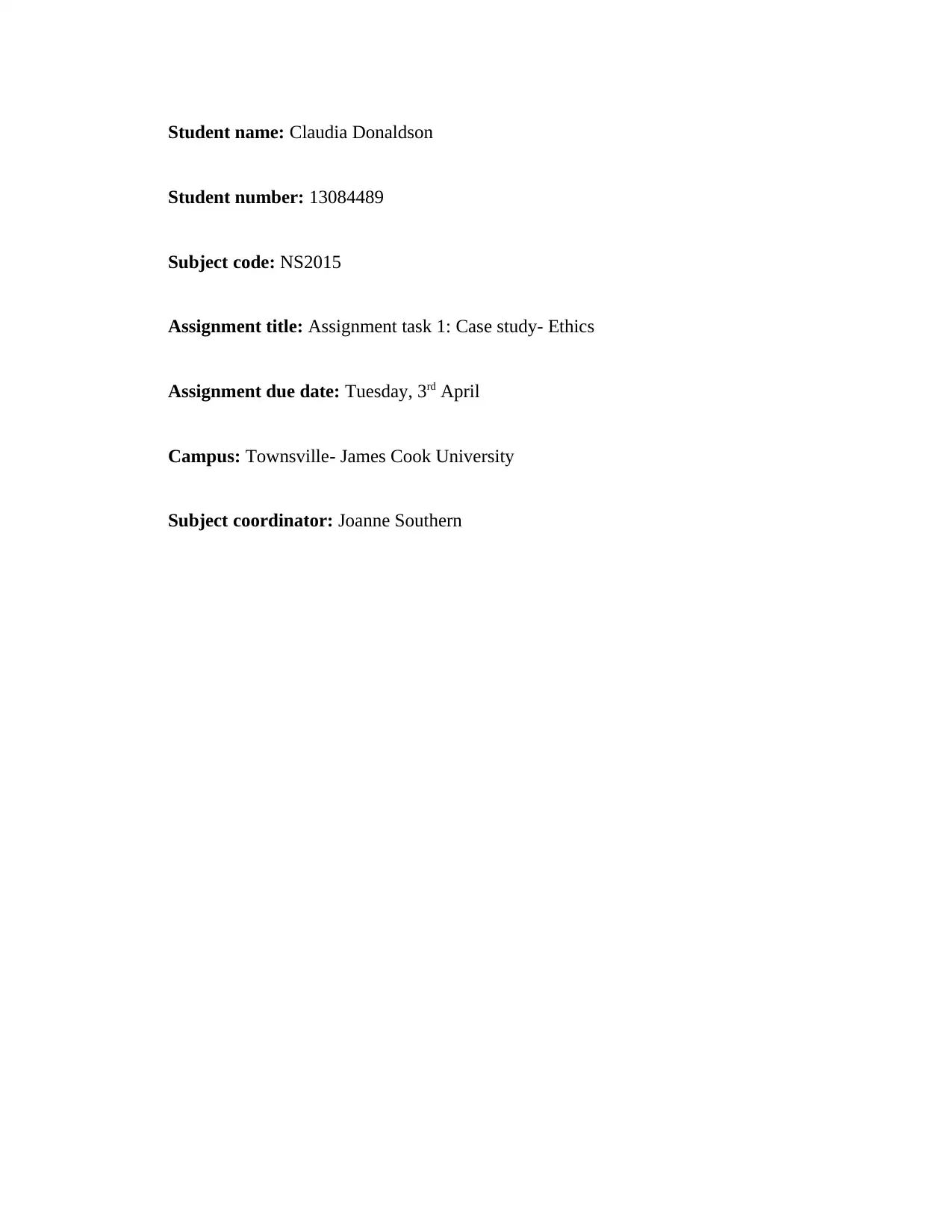
Student name: Claudia Donaldson
Student number: 13084489
Subject code: NS2015
Assignment title: Assignment task 1: Case study- Ethics
Assignment due date: Tuesday, 3rd April
Campus: Townsville- James Cook University
Subject coordinator: Joanne Southern
Student number: 13084489
Subject code: NS2015
Assignment title: Assignment task 1: Case study- Ethics
Assignment due date: Tuesday, 3rd April
Campus: Townsville- James Cook University
Subject coordinator: Joanne Southern
Secure Best Marks with AI Grader
Need help grading? Try our AI Grader for instant feedback on your assignments.

Introduction
The code of ethics for nursing professionals in Australia is a guideline that helps to
provide a framework to the healthcare professionals to comply with the United Nations human
rights and social and cultural rights (Storch et al., 2013). In this assignment, relating with the
given case study, ethical principles for physical restraining the patients will be discussed. Further
alternative ways to eliminate the physical restrain from the process of patient control will be
discussed in this section.
Ethical principles
The ethical code of nursing practice is an important guideline for practice as it helps to
uphold the patient’s dignity, respect, and helps to promote the fundamental rights of them while
receiving care in the healthcare facility (Nursing and Midwifery Board of Australia (NMBA),
2008). Further, in the fundamental rights, the right of nursing professionals is also taken care of.
According to the case study, while working in the emergency department of the hospital where
all the beds are occupied by critically ill patients, it is challenging to take equal care of each
patient. Further, a situation arises where while collecting sample from Mrs. Stock. Mr. Bogg
started yelling, creating chaos in the ED. RN moss and RN Pine and I were busy collecting
samples (Nursing and Midwifery Board of Australia (NMBA), 2008). Therefore, physical
restrain was the only option available to calm the patients. However, according to the code of
ethics nurses should value respect and kindness for their patients and others. Moreover,
according to the code of ethics, if any trait of a patient seems harmful for other patients staying
in the same ward, it is the responsibility of the nursing professionals to calm the patient.
1
The code of ethics for nursing professionals in Australia is a guideline that helps to
provide a framework to the healthcare professionals to comply with the United Nations human
rights and social and cultural rights (Storch et al., 2013). In this assignment, relating with the
given case study, ethical principles for physical restraining the patients will be discussed. Further
alternative ways to eliminate the physical restrain from the process of patient control will be
discussed in this section.
Ethical principles
The ethical code of nursing practice is an important guideline for practice as it helps to
uphold the patient’s dignity, respect, and helps to promote the fundamental rights of them while
receiving care in the healthcare facility (Nursing and Midwifery Board of Australia (NMBA),
2008). Further, in the fundamental rights, the right of nursing professionals is also taken care of.
According to the case study, while working in the emergency department of the hospital where
all the beds are occupied by critically ill patients, it is challenging to take equal care of each
patient. Further, a situation arises where while collecting sample from Mrs. Stock. Mr. Bogg
started yelling, creating chaos in the ED. RN moss and RN Pine and I were busy collecting
samples (Nursing and Midwifery Board of Australia (NMBA), 2008). Therefore, physical
restrain was the only option available to calm the patients. However, according to the code of
ethics nurses should value respect and kindness for their patients and others. Moreover,
according to the code of ethics, if any trait of a patient seems harmful for other patients staying
in the same ward, it is the responsibility of the nursing professionals to calm the patient.
1
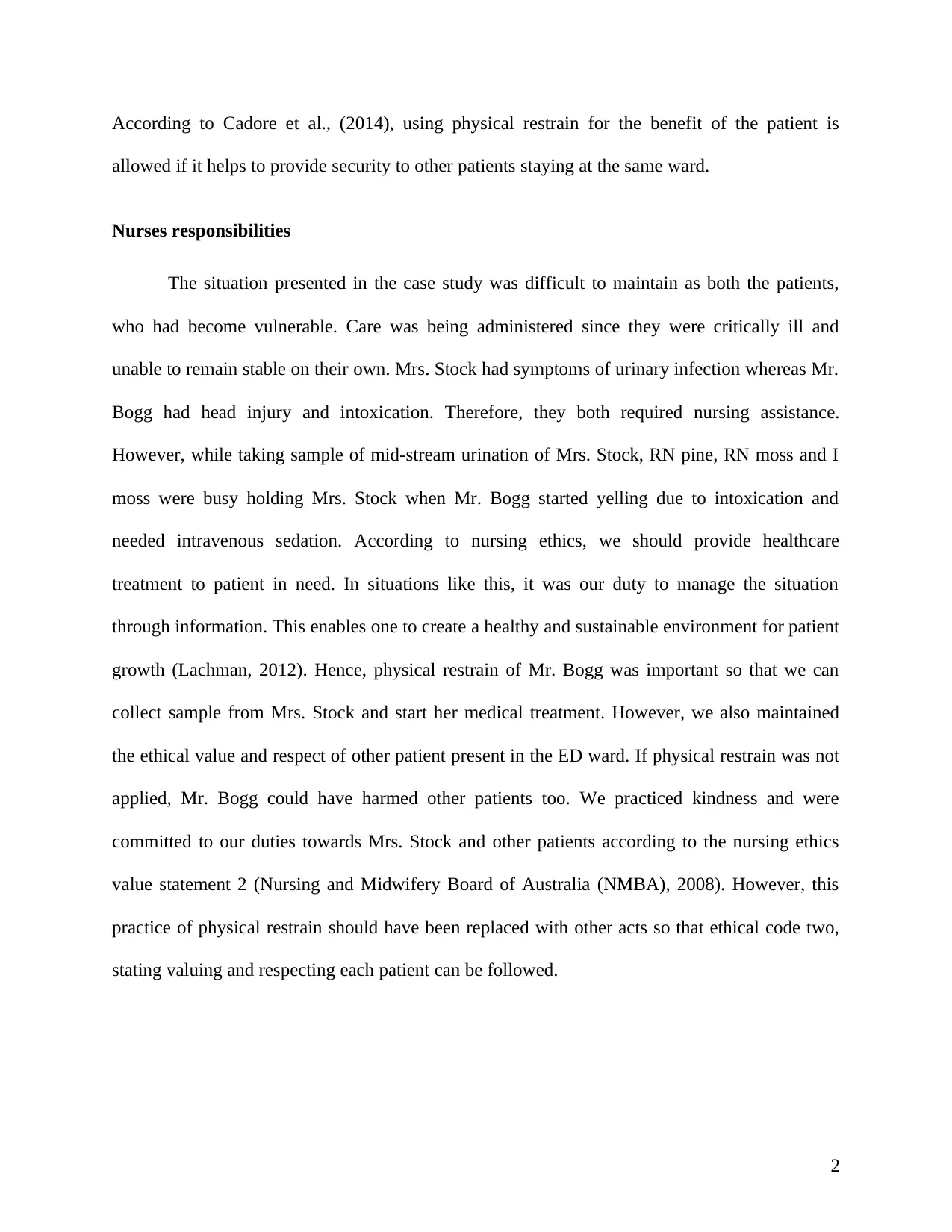
According to Cadore et al., (2014), using physical restrain for the benefit of the patient is
allowed if it helps to provide security to other patients staying at the same ward.
Nurses responsibilities
The situation presented in the case study was difficult to maintain as both the patients,
who had become vulnerable. Care was being administered since they were critically ill and
unable to remain stable on their own. Mrs. Stock had symptoms of urinary infection whereas Mr.
Bogg had head injury and intoxication. Therefore, they both required nursing assistance.
However, while taking sample of mid-stream urination of Mrs. Stock, RN pine, RN moss and I
moss were busy holding Mrs. Stock when Mr. Bogg started yelling due to intoxication and
needed intravenous sedation. According to nursing ethics, we should provide healthcare
treatment to patient in need. In situations like this, it was our duty to manage the situation
through information. This enables one to create a healthy and sustainable environment for patient
growth (Lachman, 2012). Hence, physical restrain of Mr. Bogg was important so that we can
collect sample from Mrs. Stock and start her medical treatment. However, we also maintained
the ethical value and respect of other patient present in the ED ward. If physical restrain was not
applied, Mr. Bogg could have harmed other patients too. We practiced kindness and were
committed to our duties towards Mrs. Stock and other patients according to the nursing ethics
value statement 2 (Nursing and Midwifery Board of Australia (NMBA), 2008). However, this
practice of physical restrain should have been replaced with other acts so that ethical code two,
stating valuing and respecting each patient can be followed.
2
allowed if it helps to provide security to other patients staying at the same ward.
Nurses responsibilities
The situation presented in the case study was difficult to maintain as both the patients,
who had become vulnerable. Care was being administered since they were critically ill and
unable to remain stable on their own. Mrs. Stock had symptoms of urinary infection whereas Mr.
Bogg had head injury and intoxication. Therefore, they both required nursing assistance.
However, while taking sample of mid-stream urination of Mrs. Stock, RN pine, RN moss and I
moss were busy holding Mrs. Stock when Mr. Bogg started yelling due to intoxication and
needed intravenous sedation. According to nursing ethics, we should provide healthcare
treatment to patient in need. In situations like this, it was our duty to manage the situation
through information. This enables one to create a healthy and sustainable environment for patient
growth (Lachman, 2012). Hence, physical restrain of Mr. Bogg was important so that we can
collect sample from Mrs. Stock and start her medical treatment. However, we also maintained
the ethical value and respect of other patient present in the ED ward. If physical restrain was not
applied, Mr. Bogg could have harmed other patients too. We practiced kindness and were
committed to our duties towards Mrs. Stock and other patients according to the nursing ethics
value statement 2 (Nursing and Midwifery Board of Australia (NMBA), 2008). However, this
practice of physical restrain should have been replaced with other acts so that ethical code two,
stating valuing and respecting each patient can be followed.
2
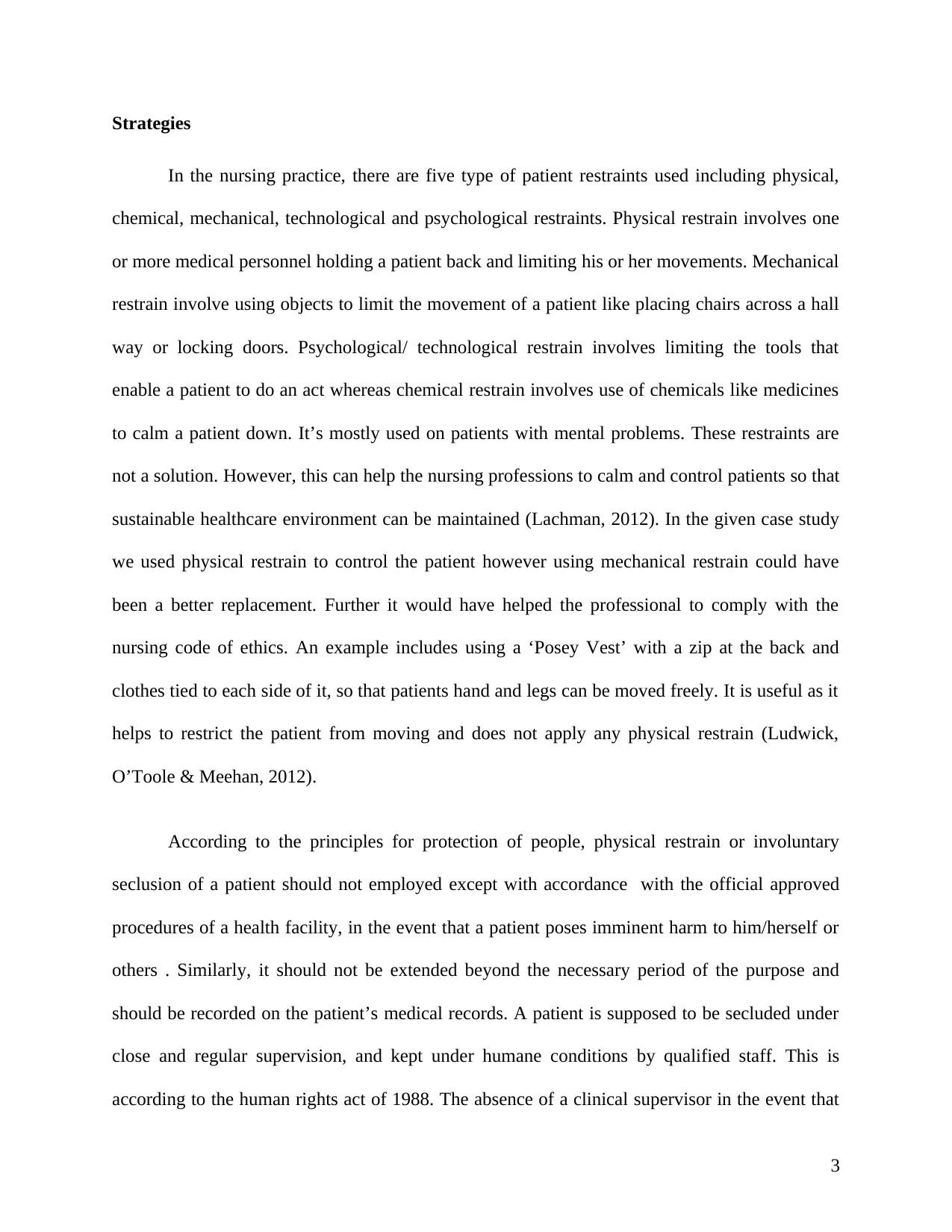
Strategies
In the nursing practice, there are five type of patient restraints used including physical,
chemical, mechanical, technological and psychological restraints. Physical restrain involves one
or more medical personnel holding a patient back and limiting his or her movements. Mechanical
restrain involve using objects to limit the movement of a patient like placing chairs across a hall
way or locking doors. Psychological/ technological restrain involves limiting the tools that
enable a patient to do an act whereas chemical restrain involves use of chemicals like medicines
to calm a patient down. It’s mostly used on patients with mental problems. These restraints are
not a solution. However, this can help the nursing professions to calm and control patients so that
sustainable healthcare environment can be maintained (Lachman, 2012). In the given case study
we used physical restrain to control the patient however using mechanical restrain could have
been a better replacement. Further it would have helped the professional to comply with the
nursing code of ethics. An example includes using a ‘Posey Vest’ with a zip at the back and
clothes tied to each side of it, so that patients hand and legs can be moved freely. It is useful as it
helps to restrict the patient from moving and does not apply any physical restrain (Ludwick,
O’Toole & Meehan, 2012).
According to the principles for protection of people, physical restrain or involuntary
seclusion of a patient should not employed except with accordance with the official approved
procedures of a health facility, in the event that a patient poses imminent harm to him/herself or
others . Similarly, it should not be extended beyond the necessary period of the purpose and
should be recorded on the patient’s medical records. A patient is supposed to be secluded under
close and regular supervision, and kept under humane conditions by qualified staff. This is
according to the human rights act of 1988. The absence of a clinical supervisor in the event that
3
In the nursing practice, there are five type of patient restraints used including physical,
chemical, mechanical, technological and psychological restraints. Physical restrain involves one
or more medical personnel holding a patient back and limiting his or her movements. Mechanical
restrain involve using objects to limit the movement of a patient like placing chairs across a hall
way or locking doors. Psychological/ technological restrain involves limiting the tools that
enable a patient to do an act whereas chemical restrain involves use of chemicals like medicines
to calm a patient down. It’s mostly used on patients with mental problems. These restraints are
not a solution. However, this can help the nursing professions to calm and control patients so that
sustainable healthcare environment can be maintained (Lachman, 2012). In the given case study
we used physical restrain to control the patient however using mechanical restrain could have
been a better replacement. Further it would have helped the professional to comply with the
nursing code of ethics. An example includes using a ‘Posey Vest’ with a zip at the back and
clothes tied to each side of it, so that patients hand and legs can be moved freely. It is useful as it
helps to restrict the patient from moving and does not apply any physical restrain (Ludwick,
O’Toole & Meehan, 2012).
According to the principles for protection of people, physical restrain or involuntary
seclusion of a patient should not employed except with accordance with the official approved
procedures of a health facility, in the event that a patient poses imminent harm to him/herself or
others . Similarly, it should not be extended beyond the necessary period of the purpose and
should be recorded on the patient’s medical records. A patient is supposed to be secluded under
close and regular supervision, and kept under humane conditions by qualified staff. This is
according to the human rights act of 1988. The absence of a clinical supervisor in the event that
3
Paraphrase This Document
Need a fresh take? Get an instant paraphrase of this document with our AI Paraphraser
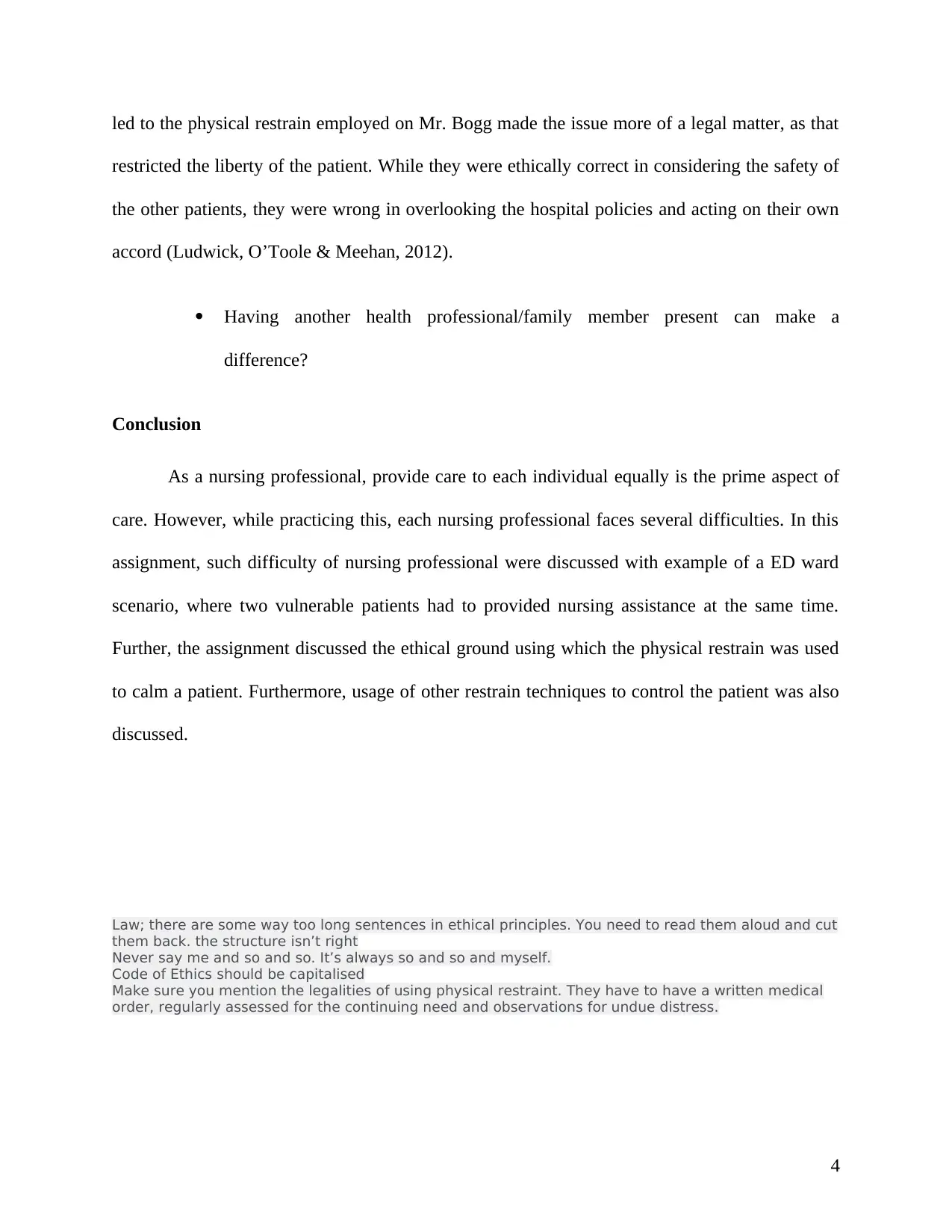
led to the physical restrain employed on Mr. Bogg made the issue more of a legal matter, as that
restricted the liberty of the patient. While they were ethically correct in considering the safety of
the other patients, they were wrong in overlooking the hospital policies and acting on their own
accord (Ludwick, O’Toole & Meehan, 2012).
Having another health professional/family member present can make a
difference?
Conclusion
As a nursing professional, provide care to each individual equally is the prime aspect of
care. However, while practicing this, each nursing professional faces several difficulties. In this
assignment, such difficulty of nursing professional were discussed with example of a ED ward
scenario, where two vulnerable patients had to provided nursing assistance at the same time.
Further, the assignment discussed the ethical ground using which the physical restrain was used
to calm a patient. Furthermore, usage of other restrain techniques to control the patient was also
discussed.
Law; there are some way too long sentences in ethical principles. You need to read them aloud and cut
them back. the structure isn’t right
Never say me and so and so. It’s always so and so and myself.
Code of Ethics should be capitalised
Make sure you mention the legalities of using physical restraint. They have to have a written medical
order, regularly assessed for the continuing need and observations for undue distress.
4
restricted the liberty of the patient. While they were ethically correct in considering the safety of
the other patients, they were wrong in overlooking the hospital policies and acting on their own
accord (Ludwick, O’Toole & Meehan, 2012).
Having another health professional/family member present can make a
difference?
Conclusion
As a nursing professional, provide care to each individual equally is the prime aspect of
care. However, while practicing this, each nursing professional faces several difficulties. In this
assignment, such difficulty of nursing professional were discussed with example of a ED ward
scenario, where two vulnerable patients had to provided nursing assistance at the same time.
Further, the assignment discussed the ethical ground using which the physical restrain was used
to calm a patient. Furthermore, usage of other restrain techniques to control the patient was also
discussed.
Law; there are some way too long sentences in ethical principles. You need to read them aloud and cut
them back. the structure isn’t right
Never say me and so and so. It’s always so and so and myself.
Code of Ethics should be capitalised
Make sure you mention the legalities of using physical restraint. They have to have a written medical
order, regularly assessed for the continuing need and observations for undue distress.
4
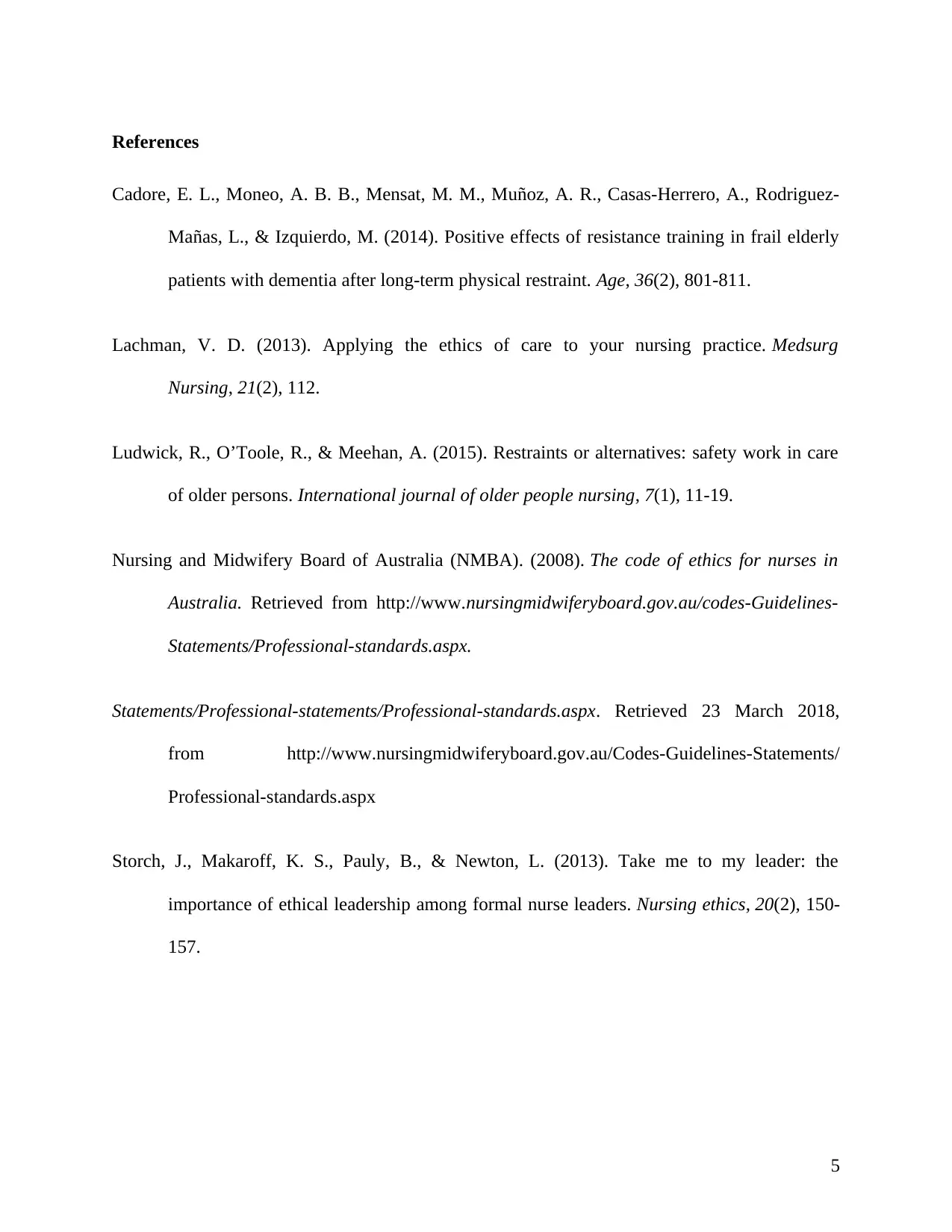
References
Cadore, E. L., Moneo, A. B. B., Mensat, M. M., Muñoz, A. R., Casas-Herrero, A., Rodriguez-
Mañas, L., & Izquierdo, M. (2014). Positive effects of resistance training in frail elderly
patients with dementia after long-term physical restraint. Age, 36(2), 801-811.
Lachman, V. D. (2013). Applying the ethics of care to your nursing practice. Medsurg
Nursing, 21(2), 112.
Ludwick, R., O’Toole, R., & Meehan, A. (2015). Restraints or alternatives: safety work in care
of older persons. International journal of older people nursing, 7(1), 11-19.
Nursing and Midwifery Board of Australia (NMBA). (2008). The code of ethics for nurses in
Australia. Retrieved from http://www.nursingmidwiferyboard.gov.au/codes-Guidelines-
Statements/Professional-standards.aspx.
Statements/Professional-statements/Professional-standards.aspx. Retrieved 23 March 2018,
from http://www.nursingmidwiferyboard.gov.au/Codes-Guidelines-Statements/
Professional-standards.aspx
Storch, J., Makaroff, K. S., Pauly, B., & Newton, L. (2013). Take me to my leader: the
importance of ethical leadership among formal nurse leaders. Nursing ethics, 20(2), 150-
157.
5
Cadore, E. L., Moneo, A. B. B., Mensat, M. M., Muñoz, A. R., Casas-Herrero, A., Rodriguez-
Mañas, L., & Izquierdo, M. (2014). Positive effects of resistance training in frail elderly
patients with dementia after long-term physical restraint. Age, 36(2), 801-811.
Lachman, V. D. (2013). Applying the ethics of care to your nursing practice. Medsurg
Nursing, 21(2), 112.
Ludwick, R., O’Toole, R., & Meehan, A. (2015). Restraints or alternatives: safety work in care
of older persons. International journal of older people nursing, 7(1), 11-19.
Nursing and Midwifery Board of Australia (NMBA). (2008). The code of ethics for nurses in
Australia. Retrieved from http://www.nursingmidwiferyboard.gov.au/codes-Guidelines-
Statements/Professional-standards.aspx.
Statements/Professional-statements/Professional-standards.aspx. Retrieved 23 March 2018,
from http://www.nursingmidwiferyboard.gov.au/Codes-Guidelines-Statements/
Professional-standards.aspx
Storch, J., Makaroff, K. S., Pauly, B., & Newton, L. (2013). Take me to my leader: the
importance of ethical leadership among formal nurse leaders. Nursing ethics, 20(2), 150-
157.
5
1 out of 6
Related Documents
Your All-in-One AI-Powered Toolkit for Academic Success.
+13062052269
info@desklib.com
Available 24*7 on WhatsApp / Email
![[object Object]](/_next/static/media/star-bottom.7253800d.svg)
Unlock your academic potential
© 2024 | Zucol Services PVT LTD | All rights reserved.





